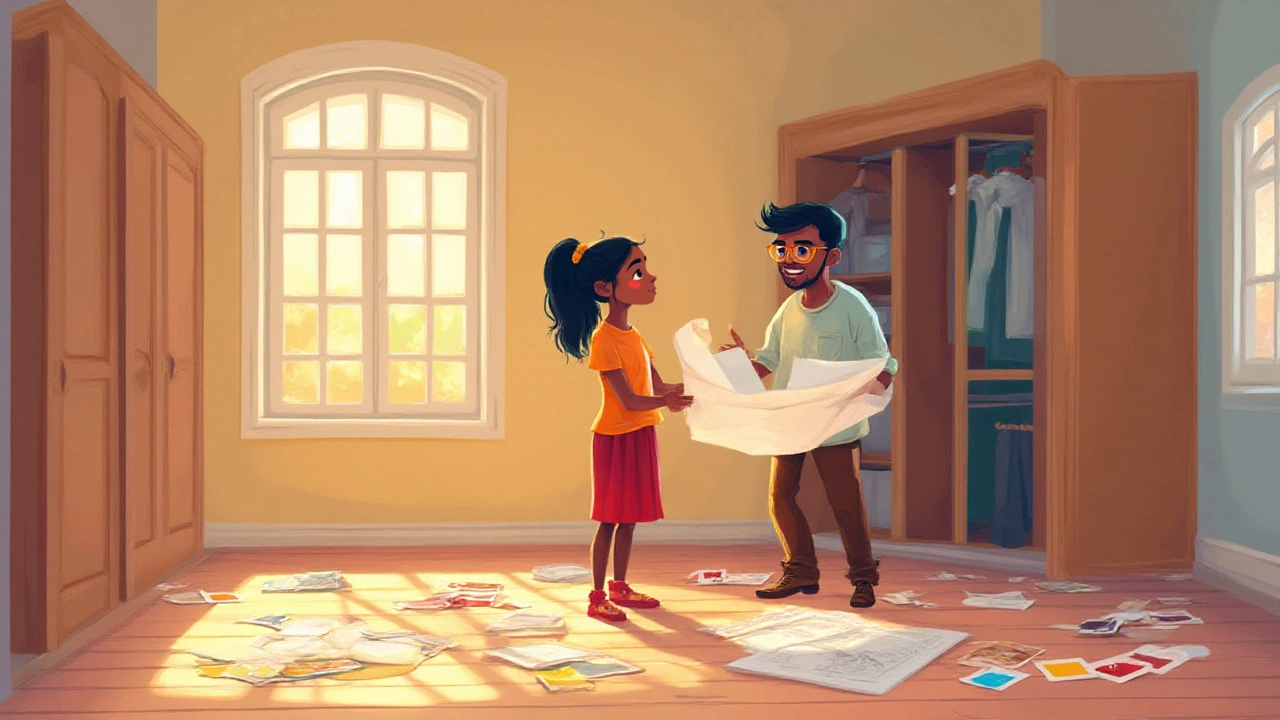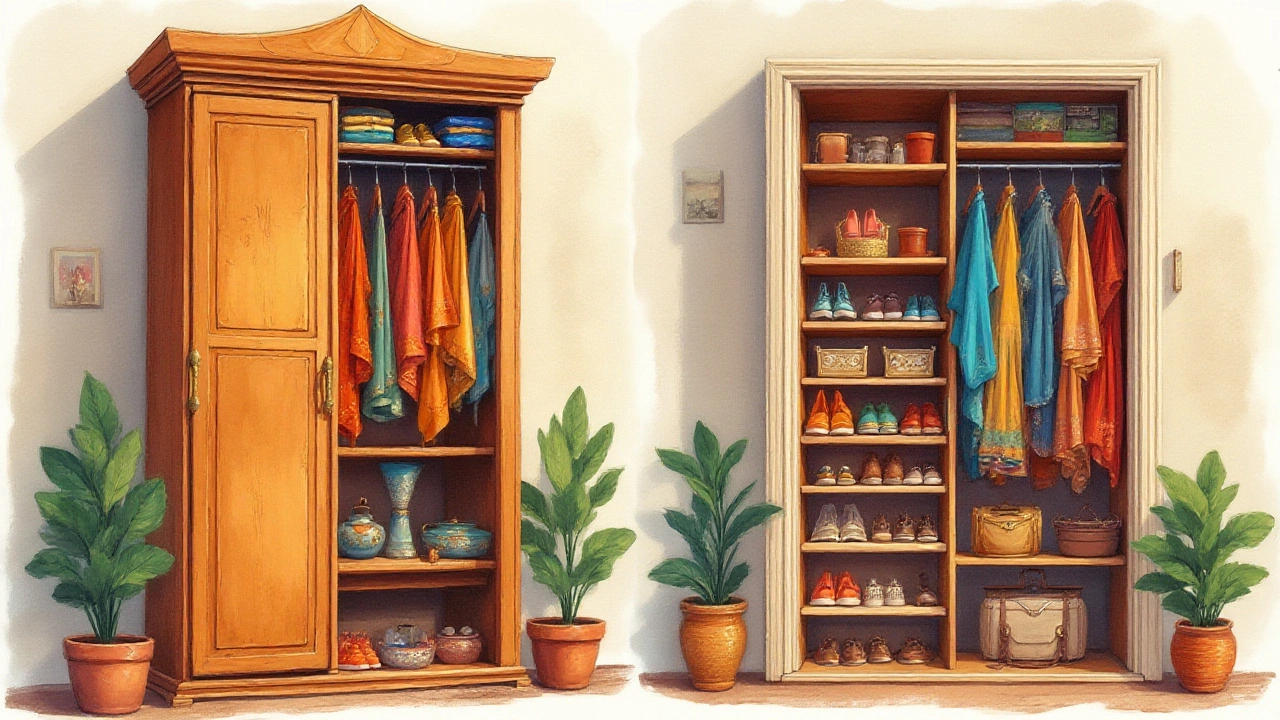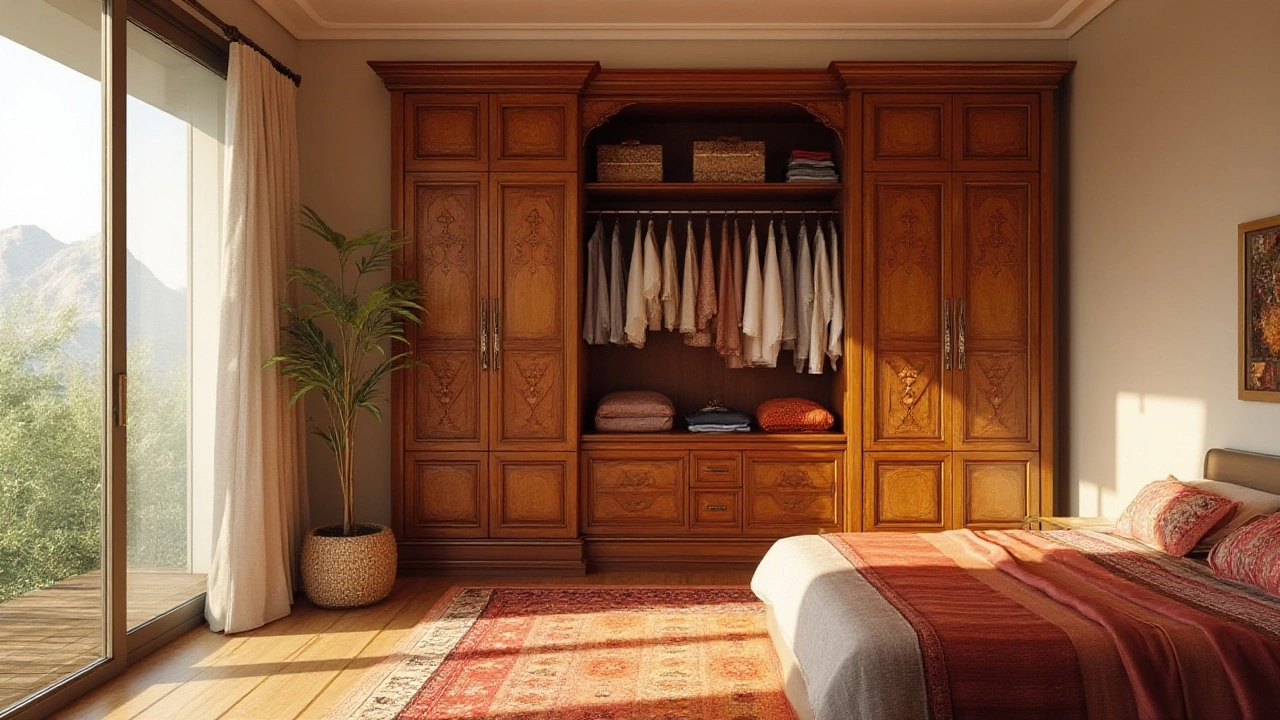Ever stood staring at your clothes pile and wondered if you’d be better off calling a carpenter or hitting the furniture store? Closet and wardrobe—these words get tossed around like they mean the same thing. But they don’t, not even close. The difference between a closet and a wardrobe is not just about style or country slang. The way your stuff lives, breathes, and hides away depends on the choice. It’s the invisible fork in your organization journey—and believe me, your socks can feel the difference. So why does the world have two words for basically a box for your clothes? Well, hang tight, you’re about to find out why it matters and how it can change your daily routine.
How Closets and Wardrobes Came to Be
Take a step back into history, and you'll see the divide between closets and wardrobes is a story of architecture, culture, and practicality. The word "closet" comes from the Latin "clausum," meaning closed space. Originally, in old castles and manor houses, a closet was a tiny private room—a place people could meditate in or keep valuables. But as homes got smaller and privacy started being about having a door between you and your socks, the closet shape-shifted from room to storage nook. In North America, closets as built-in features really kicked off in the early 20th century. Large new homes, especially post-WWII, rolled out with bits of wall carved out, the expectation being everyone needed somewhere to stow away clothes and luggage.
Flip the map, and wardrobes walk tall across Europe. A "wardrobe" actually started out as a term for a royal’s clothing collection, not the furniture itself. The French called it "garderobe," which morphed into a freestanding cabinet. These grand pieces of furniture stood in bedrooms because older houses didn’t have closets built in—thick stone walls weren’t for carving holes into. Royals needed massive, ornate wardrobes, crafted by hand and built to last generations. Funky carvings, fancy handles, all that jazz. As times changed, homes got smaller, but the love for the wardrobe stayed. Even now, many UK and European homes wouldn’t be caught dead without a wardrobe, because even modern houses often skip the dusty closet concept altogether.
The truth is, these origins do more than just tell a fancy backstory. They affect everything about how you buy, use, and even talk about storage today. Whether you're house-hunting on Zillow or browsing IKEA, what you call your storage space can depend as much on where you are as what you need. Looking to impress a Brit? Don’t call that sliding door thing a wardrobe. Talking to an American friend? They’ll probably laugh if you rave about your new oak “closet.” Geography shapes language, sure, but it shapes our homes even more.
Physical Differences: Closet vs. Wardrobe
This is where the real nuts and bolts get sorted out. A closet is a built-in storage space, part of the actual house. Open a door in your wall, and you step into a closet. Most closets have a rod for hanging clothes, shelves for folded items, maybe even shoe racks on the floor or organizers hanging off the door. They can run shallow—just deep enough for a hanger—or go walk-in big (cue the dream sequence of a Hollywood star's house, shoes and hats lined up like trophies). Walk-in closets can even feel like a mini-room, with space to get ready, lay out tomorrow's outfit, or just escape messy laundry for a minute of peace. Thanks to the way modern builders design homes in North America, closets are often in every bedroom, so everyone gets their own slice of organization heaven.
Now, wardrobes? This is a movable piece of furniture. Imagine a big cabinet, usually with two or more doors that swing open. Inside, you’ll find some combination of hanging space, shelves, and sometimes drawers. The biggest difference? You buy a wardrobe; you don’t build it. Move to a new house? Wardrobe comes with you. That’s both the magic and the trouble. Because it’s not fixed in the wall, you can fit a wardrobe into oddly shaped rooms, rental flats, or anywhere the landlord won’t let you rip things up. Sometimes, wardrobes stand over six feet tall. They can be basic—think a simple white cupboard—or super fancy with carved wood and mirrored doors, inherited from grandma or scored at an antique market.
Getting practical, the closet takes up less floor space because it uses wall cavities, while wardrobes demand their own patch on your carpet or floorboards. Closets usually give more hanging space, because they stretch the length of a wall. Wardrobes, meanwhile, are often narrower, focusing on maximizing storage above and below the hanging rod. Assembly is another big divide. Closets get built and painted along with the room. No Allen wrench required. Wardrobes, on the other hand, arrive flat-packed (thanks, IKEA) or as heavy blocks that take some real muscle to move or put together. For customization, closets can be as personalized as your budget allows—think cubbies for shoes, slide-out mirrors, special tie racks. Wardrobes have shelf and hanging layouts too, but speed and simplicity are their thing. Still, some modern wardrobes even have built-in lights, charging ports, or secret compartments. How’s that for an upgrade?

Choosing Between Closet and Wardrobe: What’s Right for You?
If you’re staring at an empty bedroom or stewing over clutter, you’ll want to pick what truly fits your life and your space. Closets win hands-down if you're building or renovating. Since they’re baked into the room, you save that precious floor area for other furniture, and you can go wild customizing the inside. Built-ins almost always add to the home’s value, which turns out handy if you ever decide to sell. If you live somewhere with regular humidity or temperature swings, a closet seals your stuff away better, too. Mold and mildew hate a dry, closed-up space. Think walk-in? If you have the spare square footage and want that bit of daily luxury, it’s a no-brainer. Pro tip: add soft lighting and an ottoman if your closet’s big enough.
But life isn’t all remodels and property values. A wardrobe is a slam dunk if you’re renting (who wants to invest in custom closets in someone else’s place?). Moving often? Wardrobes go with you, no problem. On a budget, basic MDF or laminate wardrobes from big box stores are way cheaper up front than a full closet reno. If your room has sloped ceilings, irregular corners, or windows that take up precious wall real estate, wardrobes offer flexibility that built-in closets just can’t touch. Want to change layout as your needs change? Move the wardrobe, or get rid of it and pick a new style when you feel like it. For shared bedrooms or kids sharing a space, a wardrobe means you get clear, personal territory—no fights over who gets which shelf.
If aesthetic matters to you, wardrobes give you a serious design punch. Funky colors, retro mirrors, or antique vibes, wardrobes can become a visual anchor in your bedroom. Need extra drawers or a jewelry cabinet? Look for a wardrobe with add-ons inside. Give your shoes the spotlight with shoe storage compartments at the bottom. Just keep in mind the visual weight: a wardrobe is usually more “in your face” in a room than a closet, which tucks away neatly behind a plain or sliding door.
If you struggle keeping organized, closets with built-in shelving systems might be your best friend. They can be designed to fit exactly how many shirts, belts, or bags you own. But if you’re after a quick fix and a place to hang tomorrow’s shirt, even a simple wardrobe from a thrift store will do the job. It really comes down to permanence versus portability, and whether you’d rather have one seamless space or a statement piece of furniture doing the storage work. Think about your daily routine and your future—you might discover you’re a wardrobe person after all, even if the home designers on TV swear by closets.
Unexpected Facts and Common Myths
Pop quiz: which takes more time to clean out, a closet or a wardrobe? Most folks would guess wardrobe, because it seems more complicated, but the answer flips if you factor in the wild amount of stuff we tend to cram into closets (hello, forgotten winter boots and five-year-old tuxedos). Here’s another quirky truth: in the U.S., listing a “walk-in closet” on a real estate ad can boost a home’s perceived value by thousands, while the presence of ornate wardrobes actually turns off some shoppers, worried about bulk or style clash. Over in Paris, the tiny apartments practically require a wardrobe, so French retailers have spent decades creating super-efficient, narrow versions—some even mount to the wall like a hybrid between closet and bookshelf.
And about those walk-in closets you see on TV—they’re a relatively new idea. Before 1950, even wealthy homes focused storage into a single chest or armoire. Most 19th century American homes didn’t even have built-in closets; instead, trunks or wardrobes did the work. A clever wardrobe trick: in humid climates, putting a cedar block inside a wardrobe drives away moths and keeps your sweaters smelling fresh. Some people claim wardrobes make rooms smaller, but that’s not always true. A tall, mirrored wardrobe bounces light and can actually make a room feel bigger—plus, you get a built-in dressing mirror without having to mount one on a wall. Ever heard of a “gentleman’s wardrobe”? It’s a smaller, often sectioned version made just for men’s suits, sometimes with secret drawers for watches and cufflinks. If you’re a collector, vintage wardrobes can be a gold mine for unique woodwork, secret compartments, and hardware you just can’t find in stores now.
What about combination storage? Many clever homeowners merge the best of both worlds—a shallow built-in closet for daily-wear, and a stylish wardrobe or armoire for off-season clothes or accessories. If you’re tight on space, try a wardrobe with extendable rods and built-in baskets. For closet owners, stick-on motion-activated lights and adjustable shelving can upgrade a “meh” closet to organization envy territory. And don’t forget, both can be hacked for non-clothing uses. Got kids? A small wardrobe becomes a craft cabinet. Living in a studio? A closet or wardrobe can store cleaning supplies, electronics, or even act as a mini-office hub if you get creative with shelving.

Tips for Maximizing Your Storage—Whatever You Choose
Whether you go for a closet or a wardrobe, the secret to sanity is in how you organize it. Closets, with their open structure, let you build shelving units or cubbies to suit your exact things. Consider a double-row hanging system if you don’t own many long dresses—shirts and pants can hang one above the other, and you instantly double your capacity. Add clear boxes for shoes so you don’t forget that killer pair you bought years ago. Install hooks on inside doors for scarves, necklaces, or ties—stuff that tangles fast. Custom shelf dividers can keep sweater stacks from toppling like Jenga. For deep or walk-in closets, rolling carts or pull-out baskets bring hidden items forward, so you don’t lose anything in the back.
Now for wardrobes: maximize the top shelf for stuff you rarely use—extra blankets, out-of-season shoes, crazy Halloween hats. Hanging organizers, like fabric shelves that loop over the rail, work magic for t-shirts and jeans. Drawer inserts separate socks and underwear (or, if we’re being honest, all the random stuff that ends up there). If your wardrobe is narrow, a pull-out hanging rail lets you access clothes without shoving everything sideways. Don’t be afraid to stack storage boxes on top of the wardrobe or slide rolling bins underneath. For kids and teens, choose a wardrobe with bright colors or chalkboard doors—they love customizing their space.
Lighting makes or breaks both spaces. Stick-on LED lights that detect motion can turn a dark closet into a boutique display. For wardrobes, a simple battery light does wonders for the hunt for mismatched socks. If you share space with a partner, color-code hangers or use shelf labels, so there’s no “whose stuff is this?” drama. Want long-term calm? Every season, do a quick edit: donate what you haven’t worn, fix what’s broken, and reshuffle worn-out items to the back. Less stuff means less stress, and whatever your storage type, clean space always feels bigger than cluttered chaos.
End of the day, the great closet versus wardrobe debate comes down to your habits, your space, and your style. No right answer—just what fits you, your clothes, and your way of life. Treat your storage with a little care and creativity, and even an old wardrobe or a basic closet can feel as sleek and satisfying as anything in a designer magazine. Now, go open those doors and tame the beast—whichever one’s hiding your favorite shirt.
